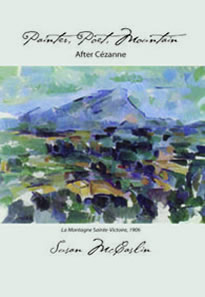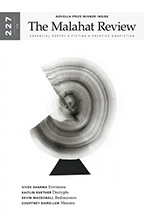Reviews
Poetry Review by Michael Roberson
Susan McCaslin, Painter, Poet, Mountain: After Cézanne (Toronto: Quattro, 2016). Paperbound, 78 pp., $18.00.
 McCaslin’s Painter, Poet, Mountain: After Cézanne operates in the ekphrastic tradition and offers renderings of the painter’s works and life, but it also investigates how that rendering might occur, “finding words for spaces where palette and pen converge.” McCaslin opens her lines “to themselves,” allowing “broken phrases,” and “gravid geometries,” to demonstrate Cézanne’s own late style—a style that anticipates Modernist abstraction. McCaslin often spreads her poems to the edges, and when she breaks a line she releases it into the space of doubt. Lines leap out and down, untethered to the margin, in hope that the “gaps” and “absences” in the poems “might contain / more than we know.” I am impressed how breaking lines and thinning syntax can evoke a sense of hesitation, or meditation, even a “crudeness,” so that, like Cézanne, McCaslin doesn’t “mind showing [her] brushstrokes.”
McCaslin’s Painter, Poet, Mountain: After Cézanne operates in the ekphrastic tradition and offers renderings of the painter’s works and life, but it also investigates how that rendering might occur, “finding words for spaces where palette and pen converge.” McCaslin opens her lines “to themselves,” allowing “broken phrases,” and “gravid geometries,” to demonstrate Cézanne’s own late style—a style that anticipates Modernist abstraction. McCaslin often spreads her poems to the edges, and when she breaks a line she releases it into the space of doubt. Lines leap out and down, untethered to the margin, in hope that the “gaps” and “absences” in the poems “might contain / more than we know.” I am impressed how breaking lines and thinning syntax can evoke a sense of hesitation, or meditation, even a “crudeness,” so that, like Cézanne, McCaslin doesn’t “mind showing [her] brushstrokes.”
McCaslin also incorporates parenthetical statements in her poems—statements that serve as notes and afterthoughts, inclusions that might (and in some cases should) have been trimmed. Still, they demonstrate the doubt that haunts her intentions—what she calls the “precisely inexact” nature of her words—and show the studied nature of the work (McCaslin notes some of her research at the end of the book). Part of the research here also comes from her own travels to Provence, an attempt to engage Cézanne’s motifs first hand. I am often distracted, however, by McCaslin’s inability to “separate the story from the art,” such as when she notes the “beatitude of skyping” both her brother and husband while in France, or when she reflects back on this time once she returns home to British Columbia.
For me, McCaslin’s three études—variations of the poem “Quantum Mountain”—anchor the book by showing her process of “poeming.” Working through the variations, she economizes language, eliminating unnecessary words and manipulating spacing and breaks, to boost the potency of individual words. She also changes from past to present tense by the third étude, in part to render Cézanne’s artistic process more alive—the poem becoming less an exercise in description and more an experience of witnessing. While exercises can often be tiresome, McCaslin’s make for effective case studies, and they remind us that art, poetry, and painting alike, are living entities.
—Michael Roberson









